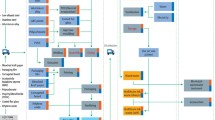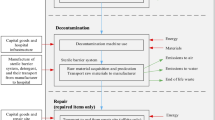Abstract
Purpose
Health care infection control has led to increased utilization of disposable medical devices, which has subsequently led to adverse environmental effects attributed to health care and its supply chain. In dental practice, the dental bur is a commonly used instrument that can be either reused or used once and then disposed. To evaluate the disparities in environmental impacts of disposable and reusable dental burs, a comparative life cycle assessment (LCA) was performed.
Methods
The functional unit was defined as one reusable dental bur, where the maximum instances reused was 30 (or in the case of a disposable, the equivalent functional unit would be 30 disposable dental burs). The system boundary included all cradle-to-grave aspects of both single-use and reused burs, including raw material extraction, manufacturing, packaging, distribution, reuse, and disposal. Primary data included the following: operating parameters for ultrasonic cleaning, manual cleaning, and autoclaving of the burs. The secondary data for raw material extraction and production of dental bur and packaging were obtained directly from life cycle inventory databases. Sensitivity analyses were also performed with respect to ultrasonic and autoclave loading.
Results and discussion
Findings from this research showed that when the ultrasonic and autoclave were loaded optimally, reusable burs had 40 % less of an environmental impact than burs used on a disposable basis. When the autoclave and ultrasonic were loaded to approximately two-third capacity, four environmental impact categories favored reusable burs (i.e., ozone depletion, smog, respiratory effects, exotoxicity), and four impact categories environmentally favored disposables (i.e., acidification, eutrophication, carcinogenics, and non-carcinogenics). When the autoclave and ultrasonic were loaded to approximately one-third capacity, reusable dental burs posed more negative environmental impacts in eight of nine environmental impact categories when compared to disposable burs.
Conclusions
Operational efficiency of ultrasonic and autoclave cleaning equipment should be emphasized to enhance the environmental performance of bur reuse. In fact, improper loading of the ultrasonic and autoclave can lead to greater adverse environmental impacts than if the burs were treated as disposables. The environmental and economic impacts associated with bur reuse are expected to be similar with other dental devices that are designated as disposable but are capable of being reused (e.g., scalpels, forceps).







Similar content being viewed by others
References
Adams E (2007) Eco-friendly dentistry: not a matter of choice. J Can Dent Assoc 73(7):581
Adegbembo AO, Watson PA (2004) Estimated quantity of mercury in amalgam waste water residue released by dentists into the sewerage system in Ontario, Canada. J Can Dent Assoc 70(11):759, 759a
Bilec MM et al (2012) Using LCA in healthcare: focus on hysterectomy surgeries. LCA XII International Conference, Tacoma
Campion N et al (2012) Life cycle assessment perspectives on delivering an infant in the US. Sci Total Environ 425:191–198
Dental mercury pollution (2005) DA 50(3):152-152
Eckelman M et al (2012) Comparative life cycle assessment of disposable and reusable laryngeal mask airways. Anesth Analg 114(5):1067–1072
Eco-Dentistry (2013) Infection control. Available from: http://www.ecodentistry.org/?Infection_Control
EIA (2014) Arizona—state profile and energy estimates. Available from: http://www.eia.gov/state/?sid=AZ#tabs-4
Farhani A, Suchak M (2007) Eco-friendly dentistry: the environmentally responsible dental practice. University of Waterloo, Waterloo
Farmer GM et al (1997) Audit of waste collected over one week from ten dental practices. A pilot study. Aust Dent J 42(2):114–117
Favero MS (2001) Requiem for reuse of single-use devices in US hospitals. Infect Control Hosp Epidemiol 22(9):539–541
Franzel M (2013) Handpiece, use, care and maintenenance. University Detroit Mercy School of Dentistry (ed)
GAO (2008) Reprocessed single-use medical devices: FDA oversight has increased, and available information does not indicate that use presents an elevated health risk: report to the Committee on Oversight and Government Reform, House of Representatives. U.S. Govt. Accountability Office, Washington, DC
Greene VW (1986) Reuse of disposable medical devices: historical and current aspects. Infect Control 7(10):508–513
Hailey D et al (2008) Reuse of single use medical devices in Canada: clinical and economic outcomes, legal and ethical issues, and current hospital practice. Int J Technol Assess Health Care 24(4):430–436
ISO 14040 (1996) Life cycle assessment. Building 46(2):4
McGain F et al (2012) A life cycle assessment of reusable and single-use central venous catheter insertion kits. Anesth Analg 114(5):1073–1080
MIS (MIS Implant Technologies Ltd) (2013) http://www.mis-implants.com/International/US.aspx
Overcash M (2012) A comparison of reusable and disposable perioperative textiles: sustainability state-of-the-art 2012. Anesth Analg 114(5):1055–1066
Shuman EK, Chenoweth CE (2012) Reuse of medical devices: implications for infection control. Infect Dis Clin N Am 26(1):165–172
Statim Autoclaves (2013) Available from: http://statim.us/sterilization/statim/#!/~/category/id=631049
Suter P et al (2009) Telehealth infection control: a movement toward best practice. Home Health Nurse 27(5):319–323
TRACI (Tool for the Reduction and Assessment of Chemical and Other Environmental Impacts) (2013) EPA (ed), Washington, DC
Ultrasonic Cleaning Systems (2013) Available from: http://www.lrultrasonics.com/industries/jewelry/quantrex.html
US Food and Drug Administration (FDA) (2009) Executive summary: survey on the reuse and reprocessing of single-use devices (SUDs) in US hospitals. US Dept of Health and Human Services (ed)
Acknowledgments
The authors would like to thank the dentists, staff, and dental aides at Deer Valley Smiles for their provided data and support to this project.
Author information
Authors and Affiliations
Corresponding author
Additional information
Responsible editor: Chris Yuan
Rights and permissions
About this article
Cite this article
Unger, S.R., Landis, A.E. Comparative life cycle assessment of reused versus disposable dental burs. Int J Life Cycle Assess 19, 1623–1631 (2014). https://doi.org/10.1007/s11367-014-0769-3
Received:
Accepted:
Published:
Issue Date:
DOI: https://doi.org/10.1007/s11367-014-0769-3




